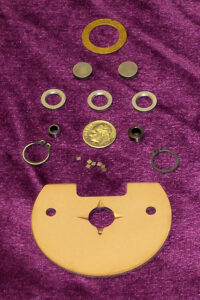
Lapping is a machining process that uses free (unfixed) abrasive to machine the surface of a given part or material. Common abrasives used in lapping, such as aluminum oxide and silicon carbide, are mixed with a liquid, called “vehicle”, to create a slurry. In the case of single-sided lapping, this slurry is pumped on to a spinning plate that carries the slurry beneath a work piece that is held in place by a hold-down pad. In double-sided lapping, the work pieces are placed within a carrier (a special gear with holes cut into it to accommodate the work piece) that is sandwiched in-between an upper and lower lapping plate. The slurry is fed in the lapping plates through a series of holes drilled into the upper plate.
The lapping process has the ability to improve the flatness, surface finish, and parallelism of the work piece as well as being able to control the thickness size to within millionths of an inch. This procedure is more superior to standard grinding methods, and it allows for tighter tolerances, improved finish, and parallelism.
More recently, processes have been developed that allow the abrasive to be fixed within the lapping plate itself so as to provide a more aggressive machining action thus removing excess stock faster without compromising flatness, parallelism, or the surface finish.